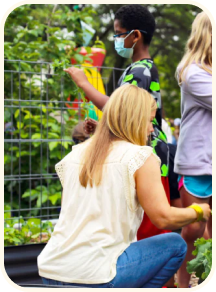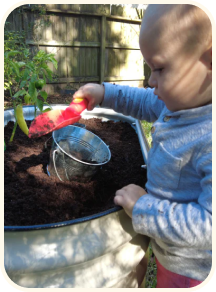Hues You Can Use: Exploring Color Theory in the Garden
Remember the childhood joy of opening a new box of crayons? Whether you carried a 16-count to school for class projects or your parents indulged your budding creativity with the 96 pack — built-in sharpener included! — there was nothing quite like spilling out the waxy, paper-wrapped sticks to unleash your imagination. So much color, so many refrigerator door-bound pictures just waiting to be drawn. And the more hues we used, the better.
Eventually, though, many of us outgrew our youthful love of riotous color combinations.
As Pablo Picasso said, “Every child is an artist. The problem is how to remain an artist once we grow up.”
No matter how subdued your tastes may be today, even if you’d never think of wearing yellow and purple together or decorating our homes in fuchsia and lime, in your garden, you can remain an artist.

Take the wheel
Sure, there are white-on-white-on-white flower gardens that are simply stunning. And when you visit the garden shop, with its potentially overwhelming selection of colors and textures, picking a monochromatic palette may seem appealing and “safe.”
But if you’re ready to let loose, here are some basic guidelines to help you move beyond random planting and create a colorful, harmonious, and deliberate design — no garish patchworks allowed.
Learn basic color theory
Before you head to the garden shop, hit up the art store for a color wheel.
A fundamental tool for understanding color relationships, the color wheel helps visualize complementary colors (those that are opposite each other), analogous colors (next to each other), and triadic colors (three evenly spaced colors).
Why is this important to gardeners?
The color wheel provides a framework that helps you envision how different flower and foliage colors will interact in your garden. By understanding complementary, analogous, and triadic color schemes, you can create intentional color combinations that achieve your desired visual effect.
For example, analogous colors look unified. Depending on your location, think about planting Coreopsis 'Moonbeam,’ a perennial with bright yellow daisy-like flowers, alongside Potentilla fruticosa 'Goldfinger,' a shrub with yellow buttercup flowers all summer. Or add vibrancy by pairing that same potentilla with a complementary color in the form of lively red-purple Salvia nemorosa 'Caradonna.'
The color wheel can also help you avoid unpleasant color clashes. Visualizing how different plants might look side-by-side can prevent the costly mistake of bringing home what winds up being jarring combinations.
Don't forget foliage

Colorful foliage makes a great backdrop for flowering plants. Consider Loropetalum 'Ruby.'
With its ruby-red new growth in spring darkening to deep burgundy as the year goes on, it is equally at home in an analogous garden (combine it, for example, with pink Dianthus 'Firewitch') or as part of a complementary design with Euphorbia characias ssp. wulfenii (a perennial with lime green bracts that resemble flowers) or Hakonechloa macra 'Aureola' (Japanese forest grass with chartreuse-colored foliage.)
Repeat complementary colors
To ensure a complementary scheme that’s also cohesive, echo the same colors throughout your garden. It doesn’t have to be the same plant — if your garden is blue (cool) and orange (warm), choose different shades of each.
Balance is key
While complementary colors can be striking, they can also be overwhelming. You’re not looking for a 50-50 split between the colors; plant more of one color and use the other as accents. Or soften the contrast by incorporating white or more neutral colored flowers or foliage.
Follow the sun
The light requirements of your preferred plants may influence your design. In general, full-sun areas can handle bolder colors while lighter, cooler hues look great in shade gardens.
Be on the lookout for new, unusual colors

The semi-dwarf Agapathus hybrid 'MP003', or African Lily Ever Amethyst, is a stunning repeat bloomer with deep purple flowers that look great with Osteospermum 'Orange Symphony' (African Daisy) or orange cosmos.
Another fairly recent introduction is Kirigami Red & White Aquilegia. It lives up to its two-tone name with large, upward-facing blooms that have red outer petals and white inner petals. And then there’s Eclipse Bigleaf Hydrangea, a mophead with cranberry blooms and leaves so dark purple they almost appear black.
Experiment and have fun
Making a color decision isn’t a lifelong commitment. Use the fact that gardens aren’t static and plants have different bloom times to your advantage: Plant early spring bulbs with analogous colors that transition to summer annuals ablaze with complementary colors.
Which is sort of like using every crayon in the box.





























Leave a comment